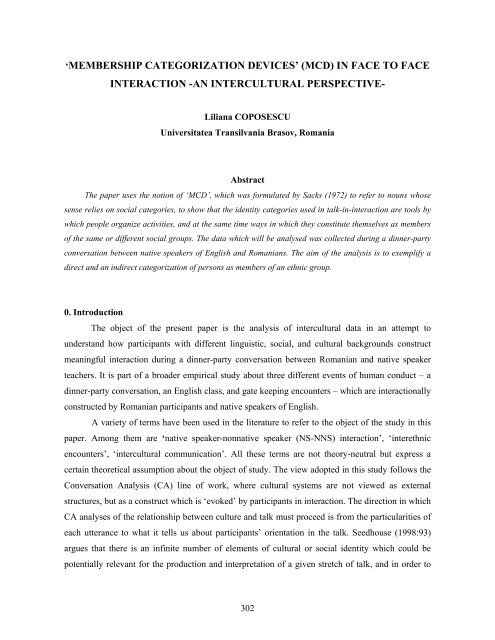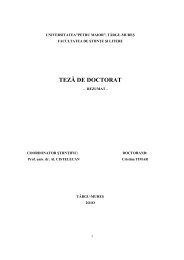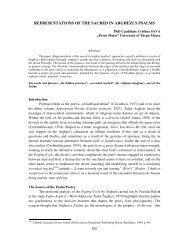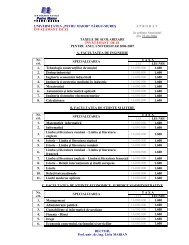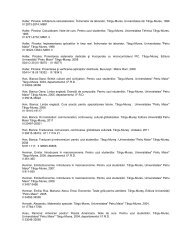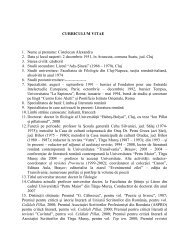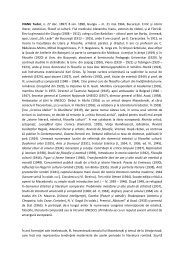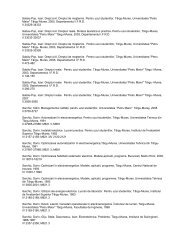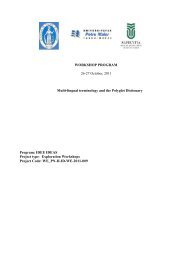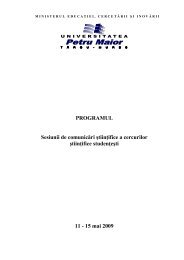'MEMBERSHIP CATEGORIZATION DEVICES' (MCD) IN FACE TO ...
'MEMBERSHIP CATEGORIZATION DEVICES' (MCD) IN FACE TO ...
'MEMBERSHIP CATEGORIZATION DEVICES' (MCD) IN FACE TO ...
Create successful ePaper yourself
Turn your PDF publications into a flip-book with our unique Google optimized e-Paper software.
‘MEMBERSHIP <strong>CATEGORIZATION</strong> DEVICES’ (<strong>MCD</strong>) <strong>IN</strong> <strong>FACE</strong> <strong>TO</strong> <strong>FACE</strong><br />
<strong>IN</strong>TERACTION -AN <strong>IN</strong>TERCULTURAL PERSPECTIVE-<br />
Liliana COPOSESCU<br />
Universitatea Transilvania Brasov, Romania<br />
Abstract<br />
The paper uses the notion of ‘<strong>MCD</strong>’, which was formulated by Sacks (1972) to refer to nouns whose<br />
sense relies on social categories, to show that the identity categories used in talk-in-interaction are tools by<br />
which people organize activities, and at the same time ways in which they constitute themselves as members<br />
of the same or different social groups. The data which will be analysed was collected during a dinner-party<br />
conversation between native speakers of English and Romanians. The aim of the analysis is to exemplify a<br />
direct and an indirect categorization of persons as members of an ethnic group.<br />
0. Introduction<br />
The object of the present paper is the analysis of intercultural data in an attempt to<br />
understand how participants with different linguistic, social, and cultural backgrounds construct<br />
meaningful interaction during a dinner-party conversation between Romanian and native speaker<br />
teachers. It is part of a broader empirical study about three different events of human conduct – a<br />
dinner-party conversation, an English class, and gate keeping encounters – which are interactionally<br />
constructed by Romanian participants and native speakers of English.<br />
A variety of terms have been used in the literature to refer to the object of the study in this<br />
paper. Among them are ‘native speaker-nonnative speaker (NS-NNS) interaction’, ‘interethnic<br />
encounters’, ‘intercultural communication’. All these terms are not theory-neutral but express a<br />
certain theoretical assumption about the object of study. The view adopted in this study follows the<br />
Conversation Analysis (CA) line of work, where cultural systems are not viewed as external<br />
structures, but as a construct which is ‘evoked’ by participants in interaction. The direction in which<br />
CA analyses of the relationship between culture and talk must proceed is from the particularities of<br />
each utterance to what it tells us about participants’ orientation in the talk. Seedhouse (1998:93)<br />
argues that there is an infinite number of elements of cultural or social identity which could be<br />
potentially relevant for the production and interpretation of a given stretch of talk, and in order to<br />
302
determine which of these elements are relevant in the interaction the analyst should limit<br />
him/herself to what the details of talk actually show.<br />
Yet the ‘intercultural’ perspective taken in the present study differs from the CA perspective<br />
in that it is also a situational one, in the sense that the intercultural encounter in itself is the central<br />
concept. The intercultural communication is before anything else ‘an instance of interpersonal<br />
communication’ (Blommaert, 1991). The only difference is that the interlocutors have a different<br />
set of values, intentions and expectations or perceptions of communicative behaviour. These<br />
differences may be activity-type (situational)-dependent, or culture-dependent. However, the<br />
interactants do not come to the encounter culturally zero-ed, but with an ‘ethnic habitus'<br />
(Hinnenkamp, 1987), which makes them part of a cultural group. More specifically, the Romanians<br />
in the dinner-party conversation are members of the ‘host culture’, where foreigners have come as<br />
peers (teachers). Presumably, the participants have expectations of cultural differences and possible<br />
breakdowns in communication, and are working out in English the types of activity they are<br />
engaged in. In other words I do not take culture as synonymous with the ethnic origin of the<br />
participants. The view does not include culture per se as a pre-determined feature, but it is the<br />
research activity that is generated by a cultural problem, namely two broad research question<br />
addressed:<br />
1. ‘How do Romanians and native speakers of English work out together the activity type of the<br />
face-to-face interaction in which they are engaged?’<br />
2. How, if at all, do participants orient to the encounter as ‘intercultural’?<br />
The paper is organized into three sections, the first describes the data collected and the<br />
methodology used, the second section is a theoretical presentation of the notion of ‘membership<br />
categorization devices’, and the third section consists of the situated analysis of part of the data. The<br />
analysis sections focus on how participants, who are more or less strangers to each other and might<br />
orient themselves to their social or cultural identities, maintain social relationships, keep the<br />
conversation going, and form a social group in itself doing a ‘dinner-party conversation’.<br />
1. Data collected and research methodology<br />
The data the present paper is based on recordings done in the house of a couple of Scottish<br />
university teachers where Romanian teachers of English and two other British native speakers were<br />
invited to a dinner-party. The sample of the data recorded is 15 minutes of talk. At the time of the<br />
recording none of the NSs of English had been in Romania for more than six months (on and off).<br />
From a cross-cultural perspective this is presumably important, if only because otherwise, they may<br />
have learned to behave in Romania in a way that is not the same as how they would have elsewhere.<br />
303
Also, they have all come to Romania foremost in their capacity as professionals (teachers of<br />
English) and they are university-educated people using mostly standard English. However, they<br />
come from different cultural backgrounds: England (in the transcript, E-Ch and E-X), and Scotland<br />
(in the transcript, S-J). R-M and R-L in the transcript stand for the two Romanian teachers.<br />
The conversation is taking place in Romania, at J’s house where other Romanian teachers of<br />
English have also been invited for dinner. The boundaries of the episode (the first utterance and the<br />
last utterance in the transcript) correspond to the speech intelligibly recorded, so they do not mark<br />
the opening and ending of conversation, but they have been imposed by technical rather than<br />
analytical reasons. However, within the episode, there are four main analytical units that I have<br />
identified according to the activities/topics and the participation framework.<br />
1. The episode starts with E-X who is already in the business of recounting a personal experience<br />
(a story) about Romanians and foreigners paying different entrance fees in museums, and<br />
ascribing ethnic categorization seems to be turned into an issue by the speaker.<br />
2. Then a new topic is proposed and ratified, and a different participation framework is<br />
established: E-X and E-Ch become addresser and addressee, while the other participants,<br />
overhearers. Both are complaining about difficulties in phoning and writing to England, and<br />
while doing so they invoke certain features of their shared identities.<br />
In the first two sub-episodes the English participants have most of the turns, whereas the Romanians<br />
R-L and R-M contribute to the conversation only once, each of them with one question.<br />
3. Then a new topic is introduced by R-M (a Romanian participant) and a different activity is<br />
initiated: asking E-X and E-Ch questions to obtain specific information: how they are being paid<br />
for their teaching job. The analysis of the episode has shown how in ordinary conversation,<br />
though participants seem confused and there are instances of misunderstanding, this does not<br />
become an issue.<br />
4. At line 58, when S-J joins in, a different topic is proposed and a new activity is going on, to<br />
which all five participants contribute: laughing together about Romanian cuisine. The humour<br />
identified in the episode is achieved through irony in interaction based on food dichotomies.<br />
The present paper focuses on the first sub-episode, in an attempt to show how participants at<br />
talk resist the relevance of linguistic ethnic group categorisation. Ethnomethodological conversation<br />
analysis and interactional sociolinguistics provide both a theoretical perspective and also the<br />
analytical practice. The theoretical principles of CA that has guided the collection and analysis of<br />
the data have been that the analysis of talk-in-interaction should be based on naturally occurring<br />
304
data, that understanding is a publicly displayed interactional accomplishment of the participants,<br />
and that talk is always situated. The study follows the CA analytical practices of data, i.e. a<br />
sequential, turn-by-turn analysis of talk. Interactional sociolinguistics provides a way of interpreting<br />
what the participants are doing when talking to each other.<br />
I have also drawn on Levinson’s (1992) concept of ‘activity type’, which he defines as:<br />
‘…a fuzzy category whose focal members are goal-defined, socially constituted, bounded<br />
events with constraints on participants, setting, and so on, but above all on the kinds of<br />
allowable contributions. Paradigm examples would be teaching, a job interview, a jural<br />
interrogation, a football game, a task in a workshop, a dinner-party and so on’. (Levinson<br />
1992:69)<br />
An important assumption in Levinson’s framework is that there are structural elements which set<br />
constraints on the allowable contributions, and that these structural constraints are adapted to the<br />
‘goal’ of the activity. Because of these constraints, there are corresponding strong expectations<br />
about the functions that any utterances at a certain point in the interaction can be fulfilling.<br />
The notion of activity type, with its main point of constraints on participants’ allowable<br />
contributions in relation to activity specific rules of inference helps the analyst uncover both the<br />
rule-governed nature of encounters (in the sense of a prototypical form) and also deviations by<br />
which participants, especially those coming from different socio-cultural backgrounds, constantly<br />
re-define or re-frame the activity.<br />
2. ‘Membership categorization devices’ as analytic tool<br />
The main approach used in the data analysis of the sub-episode is the notion of ‘membership<br />
categorization device’ (henceforth <strong>MCD</strong>, Sacks, 1972, 1995) in order to see how cultural identity is<br />
used in talk when people are cast into categories. Most of the dinner-party conversation is based on<br />
the topic of cultural dichotomies and through their talk participants resist or invoke aspects of their<br />
cultural and social identities. The main argument of the paper is that, where features of cultural<br />
identities are invoked through talk, the interaction does not exhibit differences in the interpretive<br />
resources of the participants.<br />
However, ‘conversation’ is not necessitated by practical task and is less formally structured<br />
as compared to more institutionalised encounters. The point I want to make is that, in a ‘dinnerparty<br />
conversation’ participants’ expectations might primarily be to maintain social relationships<br />
and to keep the conversation going on. Individuals may, of course, have other purposes, but this<br />
seems to be the major joint purpose. One way of achieving this major purpose of the interaction is<br />
by topic management (introducing and maintaining certain topics), and I suggest that ‘dinner- party<br />
conversation’, as opposed to institutionalised interactions, is a type of encounter where cultural or<br />
305
ethnic differences are more readily turned into a topic. Hence, it may be the focus for how, if at all,<br />
participants characterise the encounter as ‘intercultural’.<br />
The aim of this section is to show, through a ‘culturally contexted conversation analysis’, by<br />
means of data examples, those instances in the dinner-party conversation in which certain culturally<br />
available distinctions are made relevant to the situation through participants’ talk.<br />
One way of doing this is by looking at how cultural identity is used in talk when people are<br />
cast into categories. This view stems from Sacks’s (e.g., 1995) work on members ‘social categories,<br />
in particular their use in establishing through talk ‘who’ interlocutors are to be seen and heard as.<br />
How people categorise each other in everyday face-to-face interaction has been of particular interest<br />
within CA studies. A central element has been the notion of ‘membership categorization device’<br />
(<strong>MCD</strong>) which was formulated by Sacks (1972) to refer to nouns whose sense relies on social<br />
categories (for example ‘mother’, ‘deviant’) and how these categories can be organised into<br />
‘natural’ collections sharing family resemblance to each other. He was particularly interested in<br />
arguing that a description or categorization of a person becomes proper through its being heard as<br />
‘relevant’ (see also Schegloff, 1991) by virtue of its falling under an <strong>MCD</strong> that is relevant to the<br />
talk at hand.<br />
The identifications of people, activities, and events by certain names carry massive<br />
implications for the sense we attach to people and their behaviour. Each identity is heard as a<br />
category from some collection of categories. For example, ‘mother’ is heard as coming from the<br />
collection ‘family’ and ‘teacher’ from the collection of ‘occupation’.<br />
Sacks calls such a collection membership categorization device (<strong>MCD</strong>). This device consists<br />
of a collection of categories (such as baby, mother, father = family; male, female=gender) and some<br />
rules about how to apply these categories. The most relevant rules that apply to the sort of analysis<br />
that I am going to do are the Standardised Relational Pair Rule, the Category-bound activities<br />
Rule, and the Location category.<br />
The Standardised Relational Pair refers to a pairing of Members such that the relation<br />
between them constitutes a locus for rights and obligations. In other words, members of a category<br />
are heard as part of a pair. Many activities done by the members are taken to be done by some<br />
particular or several particular categories of Members where the categories are categories from the<br />
membership categorization devices. Many kinds of activities are commonsensically associated with<br />
certain membership categories. So if we know what someone’s identity is, we can work out the<br />
kinds of activities in which they might engage. Similarly, by identifying a person’s activity (say<br />
‘crying’), we provide for what their social identity is likely to be. For example, ‘crying’ is<br />
associated with ‘baby’, in order to be ‘picked up’ by his mommy. Adults also may cry and an adult<br />
306
can sometimes be called, for this reason, a ‘baby’. Of course, no description is completely<br />
unambiguous.<br />
In everyday life the ambiguity of bounding an activity to a certain activity rarely occurs. For<br />
example, if we look at the activity called ‘confession’, we know that both religious people and<br />
criminals ‘confess’, but we can easily see the difference between a criminal confession and a<br />
religious confession.<br />
Location categories (Schegloff, 1972) refer to speakers using places to do the interactional<br />
work of conversation. As Schegloff’s work on ‘formulating place’ (1972:88) has shown,<br />
…there are relationships between the identifications made (by the parties) of the parties to<br />
the conversation, on the one hand (“membership categorizations” […]), and the selection<br />
and hearing of location formulation, on the other.’<br />
In other words, location formulations by conversationalists are related to the categories of members<br />
of the society of which the hearers and speakers as well are members. The use of certain<br />
formulations of a location will allow the interlocutor to hear that the speaker is for some<br />
membership class a stranger.<br />
3. Resisting the relevance of linguistic ethnic group categorization<br />
The analysis below attempts to show that the identity categories used in talk-in-interaction<br />
are tools by which people organize activities, and at the same time ways in which they constitute<br />
themselves as members of the same, or different social groups. The specific groups that become<br />
relevant through talk in the two episodes under analysis in this section are the groups: ‘Romanians’<br />
vs ‘foreigners’.<br />
I am borrowing the term ‘linguistic ethnic group categorization’ from Day (1998: 155) to<br />
refer to the linguistic categorization of a person as a member of an ethnic group. I include in this<br />
term the broader categorization ‘foreigner’ as opposed to ‘Romanian’, which is invoked in the data.<br />
A person can be categorized directly, being referred to with a lexically obvious ethnic group label<br />
(for example Romanian, English, etc.). Alternatively, a speaker may succeed in categorizing<br />
someone into a certain linguistic ethnic group in an oblique or indirect way, by describing some<br />
other person or thing that might share some attributes with the members of a category.<br />
To exemplify these two sorts of categorization, I will refer to those instances of talk where<br />
direct linguistic ethnic reference is made by participants (example DP 1-18). The analysis will<br />
follow the CA principle of relevancy, in other words the idea that one should take for analysis only<br />
those categories that participants make relevant, or orient to. That is to say, in categorizing an<br />
individual or collection of individuals any description may only be partial, and it is up to the local<br />
307
participants to gauge how it is that the candidate linguistic ethnic group characterization is relevant<br />
to the activity at hand.<br />
The episode below is an illustration of how ascribed linguistic ethnic group characterization<br />
(‘foreigner’ vs ‘Romanian’) is resisted by participants in the interaction. This is done by focusing<br />
the analysis on the personal account told by E-X, and then by the way in which it is responded to by<br />
the participants.<br />
DP 1-18<br />
[approx. 15 seconds unintelligible talk]<br />
1 E-X: it was seven thousand lei for (.) Romanians<br />
and thirty thousand for foreigners.(1)<br />
and I was with the school<br />
so the school says (.) right, keep quiet ha.<br />
5 [laughter 2 sec.]<br />
I will get you in as a Romanian, and (I’ll look proud and)[unclear]<br />
[laughter]<br />
and every now and again one of the teachers would come up to me<br />
and explain in English what was going on whispering in my ear.<br />
10 [laughter]<br />
er it was fantastic. the amount of (.) work that’s gone into it.<br />
it’s a (purge).<br />
and the amount of money that must ve been spent.<br />
R-L: and when when were you there?<br />
15 E-X: two weeks ago.<br />
R-L: two weeks ago.<br />
E-X: yes (.) Buşteni.<br />
R-L: mhm.<br />
E-X: [unclear] and last weekend we went to a school we didn’t know [unclear]<br />
The story<br />
The example starts with E-X’s extended turn at talk and ends with R-L’s recipient token in<br />
line 18. At line 1 E-X is already having the floor, and his extended turn ends with line 13. The<br />
relatively extended single turn at talk shows that E-X is telling a story in which he recounts a school<br />
visit, presumably to a museum. From the point of view of the topic of the story, all the members of<br />
the group seemingly share the features of ‘tourists’ who ‘are visiting a museum’. However, in the<br />
first line a different linguistic group characterization is done: ‘Romanians’ vs ‘foreigners’.<br />
308
One can notice that E-X’s turn consists of three moves:<br />
• In the first line, E-X gives a factual account about different entrance fees to the museum for<br />
Romanians and foreigners. Notice that there is a slight pause after the utterance where the<br />
categorization is done - a turn-transitional place – but no other participant picks the floor. It<br />
functions as the reasons why the story is told, and the story is concerned with showing how<br />
easily a foreigner can pass as a Romanian, than with telling the story of a particular event.<br />
• The second move (lines 2-9) consists of the story itself: E-X introduces the participants and<br />
recounts the events. The incidents themselves focus on the significance of the events in relation<br />
to the ascribed identities in the first utterance and rely on the participants’ interpretation of the<br />
events.<br />
• Finally, the evaluation (lines 11-14) which, contrary to the expectation set up by the<br />
development of the story, refers to the work and money invested in ‘it’ (presumably the<br />
museum), rather than to anything related to the events in the story.<br />
By telling the story, I suggest that E-X is actually resisting the relevance of the ascribed<br />
categorization Romanian vs foreigner in two indirect, oblique ways: distancing himself from the<br />
issue by establishing the factual status of his story; and bracketing the story within a joking frame.<br />
The factual account in line 1 has a sensitive character in that ethnic categorization is<br />
involved in it may be the basis for negative assessments about the speaker in the particular situation<br />
(Romanians and foreigners at a dinner-party). That is, on the basis of E-X’s utterances he leaves<br />
himself open to the accusation of ethnic categorization and differentiation. Moreover, as Sacks<br />
(1972) has shown, categories are also ‘inference rich’, in the sense that there are strong expectations<br />
and conventions about them. Membership categories may conventionally be seen as having<br />
category-bound predicates, and consequently, the assignment of a person to a category ensures that<br />
‘conventional knowledge about the behaviour of people so categorized can be invoked or cited to<br />
interpret or explain the actions of the person’ (Hutchby and Wooffitt, 1998: 214).<br />
How does then E-X proceed to avoid this possible accusation? One way is to see the<br />
strategies used by the story-teller in order to establish the factual status of his recount, and hence<br />
that there is no stake or relevance in the dichotomy Romanian vs foreigner. What happens here is<br />
that the characterization Romanian vs foreigner conventionally implies that the members of the two<br />
categories speak different languages. By telling his story of how a foreigner can pass as a<br />
Romanian, E-X implicitly disavows it as relevant to the particular event. Notice that point of the<br />
story (‘I’ll get you in as a Romanian’) is done in reported speech, E-X activating the voice of a<br />
Romanian teacher, to warrant the factual claim of the event (Myers, 1999: 376-401) - that the<br />
dichotomy Romanian vs foreigner on the basis of the language is irrelevant.<br />
309
The issue raised by the story, as I have already mentioned above, may be a sensible one, but<br />
the tone and the way in which it is related is joking. With line 1, E-X proposes a topic (Romanians<br />
and foreigners), an orientation to it (joking or amusement), and an activity (laughing together). The<br />
invitation to laughter done in the laughing voice with which E-X reports the schoolmaster’s speech<br />
is aligned to by the recipients and the general laughter is joined in again in line 10. Notice that<br />
laughter occurs immediately after E-X refers to those category-bounded activities related to<br />
language as a feature that differentiates the opposing categories: ‘keep quite’ and ‘whispering in my<br />
ear’. However, in evaluating the story E-X turns to a serious tone and to a different issue.<br />
The only participant to react to the story is R-L, who in her turn orients herself not to the<br />
identity membership issue and hence to the joking tone, but to the time when the events of the story<br />
took place. E-X provides the information to which he also adds the place. In other words, E-L<br />
activates the time and place as relevant features to her understanding of the story and implicitly the<br />
serious tone, whereas E-X has activated some features of the membership categorization of the<br />
participants involved within a joking frame, and the amount of work and money invested in the<br />
museum, within a serious frame.<br />
The re-orientation of the relevance of the story (from the message to the time of the event)<br />
and of the frame has the consequence of creating a new condition relevance place and a different<br />
topic is introduced.<br />
4. Conclusion<br />
The two episode analysed in this paper was meant to illustrate how certain features of the<br />
ascribed linguistic ethnic group categorization are resisted or, alternatively, displayed through talk<br />
and made relevant to the activity that is going on. We have seen that participants at a ‚dinner-party’,<br />
coming from different cultural backgrounds, introduce, maintain and shift topics (talk about a visit<br />
to a museum and about phoning to England) as a way of conversing. In so doing they use social and<br />
cultural categories, such as Romanian vs. Foreigners, teachers, which are resisted through<br />
conversational activities such as story-telling. We have also seen that the dichotomy Romanian vs<br />
foreigner on the basis of language is turned irrelevant by participants.<br />
REFERENCES<br />
Blommaert, J., (1991) How much culture is there in intercultural communication? J.Blommaert &<br />
J. Verschueren (eds.), 13-31.<br />
Day, D., (1998) “Being Ascribed, and Resisting, Membership of an Ethnic Group”. Antaki &<br />
Widdicombe (eds.), Identities in Talk. SAGE Publications, pp. 151 171.<br />
Hinnenkamp, V.(1991) Talking a person into interethnic distinction: a discourse analytic case<br />
310
study. J. Blommaert and J. Verschueren (eds), 91-109.<br />
Hutchby, I. & Wooffitt, R. (1998): Conversation Analysis. Polity Press.<br />
Levinson, S., C., (1992) “Activity types and language”, Paul Drew and John Heritage, Talk at<br />
Work - Interaction in Institutional Settings. Cambridge University Press.<br />
Sacks, H. (1972) “On the analyzability of stories by children”. Gumperz and Hymes, (eds.),<br />
Directions in Sociolinguistics. New York: Holt, Rinehart, and Winston.<br />
Schegloff, E. A. (1991), “Reflections on Talk and Social Structure”. In D. Boden & H. Zimmerman<br />
(eds.), Talk and Social Structure. Studies in Ethnomethodology and Conversation Analysis. Polity<br />
Press, Cambridge, UK.<br />
Seedhouse, P. (1998), “CA and the analysis of foreign language interaction: A reply to Wagner”.<br />
Journal of Pragmatics 30: 85-102.<br />
*** (1995) Lectures on Conversation. Edited by Gail Jefferson, Blackwell, Oxford UK &<br />
Cambridge USA.<br />
*** (1972) “Notes on a conversational practice: formulating place”. In D. Sudnow (ed.), Studies in<br />
Social Interaction. New York, Free Press, 75-119.<br />
Transcription conventions<br />
Symbol<br />
Significance<br />
Arabic numerals line numbers<br />
. clause final falling intonation<br />
? clause final rising intonation<br />
, slight rise<br />
(.) short hesitation within a turn (less than 2 seconds)<br />
(2) inter-turn pause longer than 1 second, the number indicating the seconds<br />
= = latched utterances, with no discernible gap between the prior speaker’s and<br />
the next speaker’s talk<br />
/ the onset of overlapping talk<br />
CAPS<br />
Segments, syllables, words or sequences of words that are particularly loud<br />
relative to the surrounding talk;<br />
Underlined item segments, syllables, words or sequences of words that have particularly<br />
strong stress relative to surrounding talk<br />
: : lengthened syllables or vowels<br />
(words within transcriber’s guesses<br />
parentheses)<br />
[words in square non-verbal information and/or unclear passages<br />
311
ackets]<br />
(*) unidentified speaker<br />
italics<br />
word in Romanian<br />
Uncertain transcription. Words within parentheses indicate the guess.<br />
312


